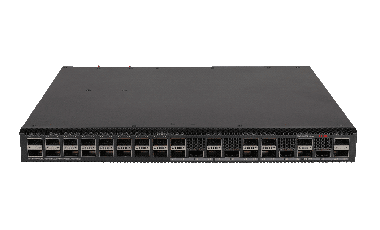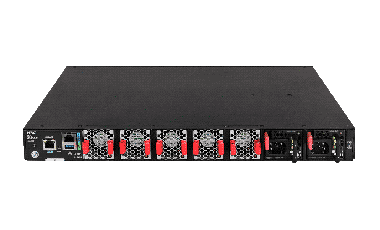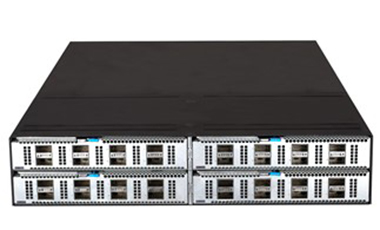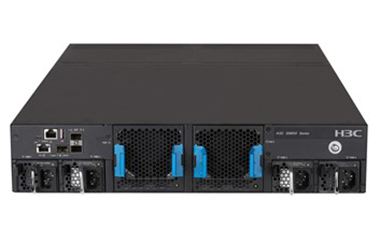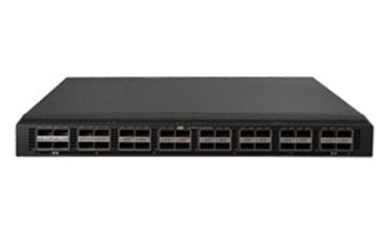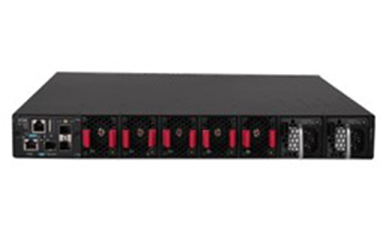- Products and Solutions
- Industry Solutions
- Services
- Support
- Training & Certification
- Partners
- About Us
- Contact Sales
- Become a Partner
-
 Login
Login
Country / Region
H3C S9850 Series Data Center Switches
H3C S9850 high-density intelligent series switches is developed for data centers and cloud computing networks. It provides powerful hardware forwarding capacity and abundant data center features. It provides up to 32*100G ports and 2 out-of-band management ports (one fiber port and one copper port). The 100G ports are 100G/40G autosensing and each can be split into four interfaces. This enables the switch to provide up to 128*25G or 10G ports. The switch supports modular power supplies and fan trays. By using different fan trays, the switch can provide field-changeable airflows.
The switch is an ideal product for high-density 100GE or 25GE accessing and aggregation at data centers and cloud computing networks. It can also operate as a TOR access switch on an overlay or integrated network.
The S9850 series switches includes two models:
![]() S9850-4C: The switch provides 4 × service slots, 2 × 1G SFP ports, 2 × fan tray slots, 2 × out-of-band management ports, 1 × mini USB console port, and 1 × USB port. The switch uses 650W AC or DC removable power modules and supports 2+2 power module redundancy.
S9850-4C: The switch provides 4 × service slots, 2 × 1G SFP ports, 2 × fan tray slots, 2 × out-of-band management ports, 1 × mini USB console port, and 1 × USB port. The switch uses 650W AC or DC removable power modules and supports 2+2 power module redundancy.
![]() S9850-32H: The switch provides 32 × 100G QSFP28 ports, 2 × 1G SFP ports, 5 × fan tray slots, 2 × out-of-band management ports, 1 × mini USB console port, and 1 × USB port. The switch uses 650W AC or DC removable power modules and supports 1+1 power module redundancy.
S9850-32H: The switch provides 32 × 100G QSFP28 ports, 2 × 1G SFP ports, 5 × fan tray slots, 2 × out-of-band management ports, 1 × mini USB console port, and 1 × USB port. The switch uses 650W AC or DC removable power modules and supports 1+1 power module redundancy.
![]() H3C S9850-32H-G: The switch provides 32 × 100G QSFP28 ports or 16 × 100G QSFP28 ports and 4 × 400G QSFP-DD ports
H3C S9850-32H-G: The switch provides 32 × 100G QSFP28 ports or 16 × 100G QSFP28 ports and 4 × 400G QSFP-DD ports
The following contents are complex, and it is recommended to browse on PC.

Enter c.h3c.com.cn on the PC browser and operate according to the page to synchronize to the PC and continue browsing.
Continue by mobile
High port density and powerful forwarding capacity
![]() The switch offers high-density 100G/40G/25G/10G ports and a forwarding capacity as high as 6.4Tbps, which enables the switch to provide high-density server access in high-end data centers without oversubscriptions.
The switch offers high-density 100G/40G/25G/10G ports and a forwarding capacity as high as 6.4Tbps, which enables the switch to provide high-density server access in high-end data centers without oversubscriptions.
IRF2 (Second Generation Intelligent Resilience Architecture)
![]() Facing the application requirements of the unified switching architecture of the data center, the series switches support the IRF2 technology, which virtualizes multiple devices into one logical.
Facing the application requirements of the unified switching architecture of the data center, the series switches support the IRF2 technology, which virtualizes multiple devices into one logical.
![]() The equipment has strong advantages in scalability, reliability, distributed and availability.
The equipment has strong advantages in scalability, reliability, distributed and availability.
![]() IRF2 not only can achieve a long-distance intelligent elastic architecture within a rack, across racks, and even across regions.
IRF2 not only can achieve a long-distance intelligent elastic architecture within a rack, across racks, and even across regions.
![]() For S9850-32H-G, IRF stacking convergency time less than 50 milliseconds.
For S9850-32H-G, IRF stacking convergency time less than 50 milliseconds.
Abundant Data Center Features
The switch supports abundant data center features, including:
![]() H3C S9850 series switches supports VXLAN (Virtual Extensible LAN), which provides two major benefits, higher scalability of Layer 2 segmentation and better utilization of available network paths.
H3C S9850 series switches supports VXLAN (Virtual Extensible LAN), which provides two major benefits, higher scalability of Layer 2 segmentation and better utilization of available network paths.
![]() H3C S9850 series switches supports MP-BGP EVPN (Multiprotocol Border Gateway Protocol Ethernet Virtual Private Network) which can run as VXLAN control plane to simplify VXLAN configuration, eliminate traffic flooding and reduce full mesh requirements between VTEPs via the introduction of BGP RR.
H3C S9850 series switches supports MP-BGP EVPN (Multiprotocol Border Gateway Protocol Ethernet Virtual Private Network) which can run as VXLAN control plane to simplify VXLAN configuration, eliminate traffic flooding and reduce full mesh requirements between VTEPs via the introduction of BGP RR.
![]() H3C S9850 series switches support Fiber Channel over Ethernet (FCoE), which permits storage, data, and computing services to be transmitted on one network, reducing the costs of network construction and maintenance.
H3C S9850 series switches support Fiber Channel over Ethernet (FCoE), which permits storage, data, and computing services to be transmitted on one network, reducing the costs of network construction and maintenance.
![]() H3C S9850 series switches support Priority-based Flow Control (PFC), Enhanced Transmission Selection (ETS) and Data Center Bridging eXchange (DCBX). These features ensure low latency and zero packet loss for FC storage, RDMA applications and high-speed computing services.
H3C S9850 series switches support Priority-based Flow Control (PFC), Enhanced Transmission Selection (ETS) and Data Center Bridging eXchange (DCBX). These features ensure low latency and zero packet loss for FC storage, RDMA applications and high-speed computing services.
H3C Distributed Resilient Network Interconnection (DRNI)
![]() H3C S9850 series switches support DRNI(M-LAG), which enables links of multiple switches to aggregate into one to implement device-level link backup. DRNI is applicable to servers dual-homed to a pair of access devices for node redundancy.
H3C S9850 series switches support DRNI(M-LAG), which enables links of multiple switches to aggregate into one to implement device-level link backup. DRNI is applicable to servers dual-homed to a pair of access devices for node redundancy.
![]() Streamlined topology: DRNI simplifies the network topology and spanning tree configuration by virtualizing two physical devices into one logical device.
Streamlined topology: DRNI simplifies the network topology and spanning tree configuration by virtualizing two physical devices into one logical device.
![]() Independent upgrading: The DR member devices can be upgraded independently one by one to minimize the impact on traffic forwarding.
Independent upgrading: The DR member devices can be upgraded independently one by one to minimize the impact on traffic forwarding.
![]() High availability: The DR system uses a keepalive link to detect multi-active collision to ensure that only one member device forwards traffic after a DR system splits.
High availability: The DR system uses a keepalive link to detect multi-active collision to ensure that only one member device forwards traffic after a DR system splits.
Powerful Visibility
With the rapid development of data center, the scale of the data center expands rapidly; reliability, operation and maintenance become the bottleneck of data center for further expansion. H3C S9850 series switches conform to the trend of automated data operation and maintenance, and support visualization of data center.
![]() INT (Inband-Telemetry) is a network monitoring technology used to collect data from the device. Compared with the traditional network monitoring technology featuring one query, one reporting, INT requires only one-time configuration for continuous data reporting, thereby reducing the request processing load of the device. INT can collect timestamp information, device ID, port information, and buffer information in real time. INT can be implemented in IP, EVPN, and VXLAN networks.
INT (Inband-Telemetry) is a network monitoring technology used to collect data from the device. Compared with the traditional network monitoring technology featuring one query, one reporting, INT requires only one-time configuration for continuous data reporting, thereby reducing the request processing load of the device. INT can collect timestamp information, device ID, port information, and buffer information in real time. INT can be implemented in IP, EVPN, and VXLAN networks.
![]() Provides a variety of traffic monitoring and analytic tools, including sFlow, NetStream, SPAN/RSPAN/ERSPAN mirroring, and port mirroring to help customers perform precise traffic analysis and gain visibility into network application traffic. With these tools, customers can collect network traffic data to evaluate network health status, create traffic analysis reports, perform traffic engineering, and optimize resource allocation.
Provides a variety of traffic monitoring and analytic tools, including sFlow, NetStream, SPAN/RSPAN/ERSPAN mirroring, and port mirroring to help customers perform precise traffic analysis and gain visibility into network application traffic. With these tools, customers can collect network traffic data to evaluate network health status, create traffic analysis reports, perform traffic engineering, and optimize resource allocation.
![]() Supports realtime monitoring of buffer and port queues, allowing for visible and dynamic network optimization.
Supports realtime monitoring of buffer and port queues, allowing for visible and dynamic network optimization.
![]() Supports PTP (Precision Time Protocol) to achieve highly precise clock synchronization.
Supports PTP (Precision Time Protocol) to achieve highly precise clock synchronization.
RoCE (RDMA over Converged Ethernet)
![]() Remote Direct Memory Access (RDMA) directly transmits the user application data to the storage space of the servers, and uses the network to fast transmit the data from the local system to the storage of the remote system. RDMA eliminates multiple data copying and context switching operations during the transmission process, and reduces the CPU load.
Remote Direct Memory Access (RDMA) directly transmits the user application data to the storage space of the servers, and uses the network to fast transmit the data from the local system to the storage of the remote system. RDMA eliminates multiple data copying and context switching operations during the transmission process, and reduces the CPU load.
![]() RoCE supports RDMA on standard Ethernet infrastructures. H3C S9850 switch support RoCE and can be used to build a lossless Ethernet network to ensure zero packet loss.
RoCE supports RDMA on standard Ethernet infrastructures. H3C S9850 switch support RoCE and can be used to build a lossless Ethernet network to ensure zero packet loss.
![]() RoCE include the following key features, include PFC(Priority based Flow Control), ECN(Explicit Congestion Notification), DCBX(Data Center Bridging Capability Exchange Protocol), ETS(Enhanced Transmission Selection).
RoCE include the following key features, include PFC(Priority based Flow Control), ECN(Explicit Congestion Notification), DCBX(Data Center Bridging Capability Exchange Protocol), ETS(Enhanced Transmission Selection).
Flexible programmability
![]() The switch uses industry-leading programmable switching chips that allow users to define the forwarding logic as needed.
The switch uses industry-leading programmable switching chips that allow users to define the forwarding logic as needed.
![]() Users can develop new features that meet the evolving trend of their networks through simple software updates.
Users can develop new features that meet the evolving trend of their networks through simple software updates.
Powerful SDN capacity
![]() H3C S9850 series switches adopt the next-generation chip with more flexible Openflow FlowTable, more resources and accurate ACL matching, which greatly improves the software-defined network (SDN) capabilities and meet the demand of data center SDN network.
H3C S9850 series switches adopt the next-generation chip with more flexible Openflow FlowTable, more resources and accurate ACL matching, which greatly improves the software-defined network (SDN) capabilities and meet the demand of data center SDN network.
![]() H3C S9850 series switches can interconnect with H3C SeerEngine-DC Controller through standard protocols such as OVSDB, Netconf and SNMP to implement network automatic deployment and configuration.
H3C S9850 series switches can interconnect with H3C SeerEngine-DC Controller through standard protocols such as OVSDB, Netconf and SNMP to implement network automatic deployment and configuration.
Comprehensive security control policies
![]() H3C S9850 series switch supports AAA, RADIUS and user account based authentication, IP, MAC, VLAN, port-based user identification, dynamic and static binding; when working with the H3C iMC platform, it can conduct real time management, instant diagnosis and crackdown on illicit network behavior.
H3C S9850 series switch supports AAA, RADIUS and user account based authentication, IP, MAC, VLAN, port-based user identification, dynamic and static binding; when working with the H3C iMC platform, it can conduct real time management, instant diagnosis and crackdown on illicit network behavior.
![]() H3C S9850 series switch supports enhanced ACL control logic, which enables an enormous amount of inbound and outbound ACL, and delegate VLAN based ACL. This simplifies user deployment process and avoids ACL resource wastage. S9850 series switch can also take advantage of Unicast Reverse Path Forwarding (Unicast RFP). When the device receives a packet, it will perform the reverse check to verify the source address from which the packets are supposedly originated, and will drop the packet if such path doesn’t exist. This can effectively prevent the source address spoofing in the network.
H3C S9850 series switch supports enhanced ACL control logic, which enables an enormous amount of inbound and outbound ACL, and delegate VLAN based ACL. This simplifies user deployment process and avoids ACL resource wastage. S9850 series switch can also take advantage of Unicast Reverse Path Forwarding (Unicast RFP). When the device receives a packet, it will perform the reverse check to verify the source address from which the packets are supposedly originated, and will drop the packet if such path doesn’t exist. This can effectively prevent the source address spoofing in the network.
Multiple reliability protection
![]() The S9850 series switch provides multiple reliability protection at both switch and link levels. With over current, overvoltage, and overheat protection, all models have a redundant pluggable power module, which enables flexible configuration of AC or DC power modules based on actual needs. The entire switch supports fault detection and alarm for power supply and fan, allowing fan speed to change to suit different ambient temperatures.
The S9850 series switch provides multiple reliability protection at both switch and link levels. With over current, overvoltage, and overheat protection, all models have a redundant pluggable power module, which enables flexible configuration of AC or DC power modules based on actual needs. The entire switch supports fault detection and alarm for power supply and fan, allowing fan speed to change to suit different ambient temperatures.
![]() The switch supports diverse link redundancy technologies such as H3C proprietary RRPP, VRRPE, and Smart Link. These technologies ensure quick network convergence even when large amount of traffic of multiple services runs on the network.
The switch supports diverse link redundancy technologies such as H3C proprietary RRPP, VRRPE, and Smart Link. These technologies ensure quick network convergence even when large amount of traffic of multiple services runs on the network.
Flexible choice of airflow
![]() To cope with data center cooling aisle design, the H3C S9850 series switch comes with flexible airflow design, which features bi-cooling aisles in the front and back. Users may also choose the direction of airflow (from front to back or vice versa) by selecting a different fan tray.
To cope with data center cooling aisle design, the H3C S9850 series switch comes with flexible airflow design, which features bi-cooling aisles in the front and back. Users may also choose the direction of airflow (from front to back or vice versa) by selecting a different fan tray.
Excellent manageability
The switch improves system management through the following ways:
![]() Provides multiple management interfaces, including the serial console port, mini USB console port, USB port, two out-of-band management ports, and two SFP ports. The SFP ports can be used as in-band management port through which encapsulated sampling packets are sent to the controller or other management devices for deep analysis.
Provides multiple management interfaces, including the serial console port, mini USB console port, USB port, two out-of-band management ports, and two SFP ports. The SFP ports can be used as in-band management port through which encapsulated sampling packets are sent to the controller or other management devices for deep analysis.
![]() Supports multiple access methods, including SNMPv1/v2c/v3, Telnet, SSH 2.0, SSL, and FTP.
Supports multiple access methods, including SNMPv1/v2c/v3, Telnet, SSH 2.0, SSL, and FTP.
![]() Supports standard NETCONF APIs that allow users to configure and manage the switch, enhancing the compatibility with third-party applications.
Supports standard NETCONF APIs that allow users to configure and manage the switch, enhancing the compatibility with third-party applications.
Hardware Specification
Item | S9850-4C | S9850-32H | S9850-32H-G |
PID | LS-9850-4C /LS-9850-4C-H1 | LS-9850-32H-H1 | LS-9850-32H-G |
Dimensions (H × W × D) | 88.1 × 440 × 660 mm (3.47 × 17.32 × 25.98 in) | 43.6 × 440 × 460 mm (1.72 × 17.32 × 18.11 in) | 43.6 × 440 × 400 mm (1.72 × 17.32 × 15.75 in) |
Weight(Full loaded) | ≤ 27 kg (59.53 lb) | ≤ 15 kg (33.07 lb) | ≤8kg(17.64 lb) |
Serial console port | 1 | 1 | 1 |
Out-of-band management port | One GE copper port and one GE fiber port | One GE copper port and one GE fiber port | One GE fiber port |
Mini USB console port | 1 | 1 | - |
USB port | 1 | 1 | 1 |
QSFP-DD port | 4(max) | ||
QSFP28 | / | 32 | 32(max) |
SFP port | 2 | 2 | - |
Expansion slot | 4 | - | - |
CPU | LS-9850-4C-H1: 4 cores, 2.2 GHz | LS-9850-32H-A:4 cores, 2.4 GHz LS-9850-32H-H1:4 cores, 2.2 GHz | FT 2000, 2 cores, 2.2 GHz |
Flash/SDRAM | 8GB/8GB | LS-9850-32H-A:4GB/8GB LS-9850-32H-H1:4GB/8GB | 2GB/4GB |
Latency | < 1.5μs | 25GE< 3 μs(64 byte) 100GE< 1.2 μs(64 byte) | |
Switching capacity | 6.4 Tbps | 6.4 Tbps | |
Forwarding capacity | 2024 Mpps | 1020Mpps | |
Buffer | 32M | 36M | |
AC-input voltage | 90v to 264v | 90v to 264v | 90V~290V |
DC-input voltage | –40v to –72v | –40v to –72v | -36V~-72V |
Power module slot | 4 | 2 | 2 |
Fan tray slot | 2 | 5 | 5 |
Air flow direction | From front to rear or from rear to front | From front to rear or from rear to front | From front to rear or from rear to front |
With four LSWM18CQ modules: 355 W · With four LSWM18CQMSEC modules: 443 W · With four LSWM116Q modules: 311 W · With four LSWM18QC modules: 251 W · With four LSWM124XG2Q modules: 363 W · With four LSWM124XGT2Q modules: 487 W · With four LSWM124XG2QFC modules: 363 W · With four LSWM124XG2QL modules: 275 W · With four LSWM124TG2H modules: 355 W · With four LSWM116FC modules: 311 W | Single AC: 198 W Dual AC: 210 W Single DC: 197 W Dual DC: 208 W | Single AC: 222 W Dual AC: 227 W Single DC: 232W Dual DC: 234W | |
Maximum power consumption | ·With four LSWM18CQ modules: 688 W ·With four LSWM18CQMSEC modules: 748 W ·With four LSWM116Q modules: 616 W ·With four LSWM18QC modules: 496 W ·With four LSWM124XG2Q modules: 616 W ·With four LSWM124XGT2Q modules: 868 W ·With four LSWM124XG2QFC modules: 616 W ·With four LSWM124XG2QL modules: 520 W ·With four LSWM124TG2H modules: 688 W ·With four LSWM116FC modules: 616 W | Single AC input: 376 W Dual AC inputs: 385 W Single DC input: 373 W Dual DC inputs: 377 W | Single AC input: 400 W Dual AC inputs: 390 W Single DC input: 426 W Dual DC inputs: 414 W |
·With four LSWM18CQ modules: 1211 BTU/hr ·With four LSWM18CQMSEC modules: 1512 BTU/hr ·With four LSWM116Q modules: 1061 BTU/hr ·With four LSWM18QC modules: 856 BTU/hr ·With four LSWM124XG2Q modules: 1239 BTU/hr ·With four LSWM124XGT2Q modules: 1662 BTU/hr ·With four LSWM124XG2QFC modules: 1239 BTU/hr ·With four LSWM124XG2QL modules: 938 BTU/hr ·With four LSWM124TG2H modules: 1211 BTU/hr ·With four LSWM116FC modules: 1061 BTU/hr | ·Single AC input: 676 BTU/hr ·Dual AC inputs: 717 BTU/hr ·Single DC input: 672 BTU/hr ·Dual DC inputs: 710 BTU/hr | Single AC: 757 BTU/hr Dual AC: 775 BTU/hr Single DC: 792 BTU/hr Dual DC: 789 BTU/hr | |
MTBF(years) | 45.8 | 27.2 | 64.02 |
MTTR(hour) | 1 | 1 | 1 |
Operating temperature | 0°C to 45°C (32°F to 113°F) | 0°C to 45°C (32°F to 113°F) | 0°C to 45°C (32°F to 113°F) |
Operating humidity | 5% to 95%, noncondensing | 5% to 95%, noncondensing | 5% to 95%, noncondensing |
Software Specification
Item | Feature description |
Device Virtualization | IRF |
M-LAG(DRNI) | |
S-MLAG | |
Network Virtualization | BGP-EVPN |
VxLAN | |
EVPN ES | |
VxLAN | L2 VxLAN gateway |
L3 VxLAN gateway | |
Distributed VxLAN gateway | |
Centralized VxLAN gateway | |
EVPN VxLAN | |
manual configured VxLAN | |
IPv4 VxLAN tunnel | |
IPv6 VxLAN tunnel | |
QinQ VxLAN access | |
SDN | H3C SeerEngine-DC |
Lossless network | PFC and ECN |
DCBX | |
RDMA and ROCE | |
PFC deadlock watchdog | |
ECN overlay | |
ROCE stream analysis | |
Programmability | Openflow1.3 |
Netconf | |
Ansible | |
Python//TCL/Restful/Restconf API to realize DevOps automated operation and maintenance | |
Openflow1.3 | |
Traffic analysis | Sflow |
Netstream | |
VLAN | Port-based VLANs |
Mac-based VLAN ,Subnet-based VLAN and Protocol VLAN | |
VLAN mapping | |
QinQ | |
MVRP(Multiple VLAN Registration Protocol) | |
Super VLAN | |
PVLAN | |
MAC address | Dynamic learning and aging of mac address entries |
Dynamic,static and blackhole entries | |
Mac address limiting on ports | |
IPv4 routing | RIP(Routing Information Protocol) v1/2 |
OSPF (Open Shortest Path First) v1/v2 | |
ISIS(Intermediate System to Intermediate system) | |
BGP (Border Gateway Protocol) | |
Routing policy | |
VRRP | |
PBR | |
IPv6 routing | RIPng |
OSPFv3 | |
IPv6 ISIS | |
BGP4+ | |
Routing policy | |
VRRP | |
PBR | |
MPLS/VPLS | Support L3 MPLS VPN |
Support L2 VPN: VLL (Martini, Kompella) | |
Support VPLS, VLL | |
Support hierarchical VPLS and QinQ+VPLS access | |
Support P/PE function | |
Support LDP protocol | |
Support MCE | |
Support MPLS OAM | |
Multicast | IGMP snooping |
MLD snooping | |
IPv4 and IPv6 multicast VLAN | |
IPv4 and IPv6 PIM snooping | |
IGMP and MLD | |
PIM and IPv6 PIM | |
MSDP | |
Multicast VPN | |
Reliability | LACP |
STP/RSTP/MSTP protocol, PVST/PVST+/RPVST+compatible | |
STP Root Guard and BPDU Guard | |
RRPP and ERPS | |
Ethernet OAM | |
Smartlink | |
DLDP | |
BFD for OSPF/OSPFv3, BGP/BGP4, IS-IS/IS-ISv6, PIM/IPM for IPv6 and Static route | |
VRRP and VRRPE | |
LACP | |
FC/FOCE | FC, FC subcard is supported on S9850-4C |
FCOE | |
QOS | Weighted Random Early Detection (WRED) and tail drop |
Flexible queue scheduling algorithms based on port and queue, including strict priority (SP), Weighted Deficit Round Robin (WDRR), Weighted Fair Queuing (WFQ), SP + WDRR, and SP + WFQ. | |
Traffic shaping | |
Packet filtering at L2 (Layer 2) through L4 (Layer 4); flow classification based on source MAC address, destination MAC address, source IP (IPv4/IPv6) address, destination IP (IPv4/IPv6) address, port, protocol, and VLAN to apply qos policy,including mirroring,redirection,priority remark etc. | |
Committed access rate (CAR) | |
QOS | Account by packet and byte |
COPP | |
Forwarding | Hardware-based(ASlC)Wire-speed/Line-rate architecture |
Telemetry | gRPC |
ERSPAN | |
Mirror on drop | |
Telemetry Stream | |
INT | |
iNQA | |
Packet trace, Packet capture | |
Configuration and maintenance | Console telnet and SSH terminals |
SNMPv1/v2/v3 | |
ZTP | |
System log | |
File upload and download via FTP/TFTP BootRom update and remote update | |
NQA | |
ping,tracert | |
VxLAN ping and VxLAN tracert | |
NTP | |
PTP(1588v2) | |
GIR Graceful Insertion and Removal | |
Security and management | Macsec, Macsec subcard is supported on S9850-4C and only 100G macsec subcard can support 256-bit AES encryption |
Micro-Segmentation | |
Hierarchical management and password protection of users | |
Authentication methods,including AAA,RADIUS and HWTACACS | |
Support DDos, ARP attack and ICMP attack function | |
IP-MAC-port binding and IP Source Guard | |
SSH 2.0 | |
HTTPS | |
SSL | |
PKI | |
Boot ROM access control (password recovery) | |
RMON | |
No license required for switch hardware and software functions | |
MACsec (Media Access Control Security) All ports AES256 MACsec (for S9850-32H-G) | |
TAP (Only for S9850-32H-G) | Support N:M replication based on port and traffic, with M or N ≥ 48. |
Support GRE tunnel encapsulation stripping, support same source and same host, support packet truncation. | |
Support source port identification. | |
Support adding timestamps and Ethernet headers. | |
Identify specified packets, modify MAC address or IP address, and then copy and forward. | |
EMC | FCC Part 15 Subpart B CLASS A ICES-003 CLASS A VCCI CLASS A CISPR 32 CLASS A EN 55032 CLASS A AS/NZS CISPR32 CLASS A CISPR 24 EN 55024 EN 61000-3-2 EN 61000-3-3 ETSI EN 300 386 GB/T 9254 YD/T 993 |
IEEE Standard | 802.3x/802.3ad/802.3AH/802.1P/802.1Q/802.1X/802.1D/802.1w/802.1s/802.1AG 802.1x/802.1Qbb/802.1az/802.1Qaz |
Safety | UL 60950-1 CAN/CSA C22.2 No 60950-1 IEC 60950-1, EN 60950-1 AS/NZS 60950-1 FDA 21 CFR Subchapter J GB 4943.1 |
Performance and scalability
Description | S9850-4C/32H | ||
Virtualization | IRF stack | 10 | 9 |
M-LAG device number | 2 | 2 | |
ED group | 8 | - | |
ACL | max number of ingress ACLs | 18K/pipe, total 2 pipes | 26K |
max number of ingress Car | 2304/pipe, total 2 pipes | 8191 | |
max number of ingress Counter | 10752/pipe, total 2 pipes | 26K | |
max number of egress ACLs | 2048 | 2K | |
max number of egress Car | 1K | 2047 | |
max number of egress Counter | 1K | 4096 | |
Forwarding table | Jumbo frame length(byte) | 9416 | 13312 |
Mirroring group | 4 | 8 | |
PBR policy | 1000 | 1024 | |
PBR node | 256 | 8192 | |
max number of MACs per switch | 288K max | 288K max | |
max number of ARP entries IPv4 | 272K max | 78k | |
max ND table size for IPv6 | 136K max | 78K | |
max number of unicast routes IPv4 | 324K max | 768k max | |
max number of unicast routes IPv6 | 262K max | 64K | |
IPv4 l2 multicast group | 4000 | 8K | |
IPv4 l3 multicast group | 4000 | 8K | |
IPv4 multicast routing | 128K | 100k | |
IPv6 l2 multicast group | 4000 | 8K | |
IPv6 l3 multicast group | 4000 | 8K | |
IPv6 multicast routing | 64K | 64k | |
LAGG group | 1024 | 256 | |
LAGG member per group | 256 | 64 | |
ECMP group | max 4K | 1023 | |
ECMP member per group | 2-128 | 64 | |
VRF | 4095 | 4K | |
Interface | Loopback interface number | 1K | - |
L3 sub interface number | 2500 | 4094 | |
SVI interface number | 4K | 4094 | |
VxLAN AC number | 16K | 8176 | |
VxLAN VSI number | 16K | 4096 | |
VxLAN tunnel number | 2K | 4K | |
VSI interface number | 8K | 8K | |
IPv4 tunnel number | 2K | 1024 | |
IPv6 tunnel number | 2K | 1024 | |
VLAN number | 4094 | 4K | |
Performance | RIB | 1M | 768k max |
MSTP instance | 64 | 128 | |
PVST instance | 510 | 128 | |
PVST logical port number | 2000 | No limit | |
VRRP VRID | 255 | 255 | |
VRRP group | 256 | 4k | |
NQA group | 32 | 64 | |
Static table | static mac-address | 4000 | 20K |
static multicast mac-address | 1K | 256 | |
static ARP | 1K | 78K | |
static ND | 4K | 1k | |
static IPv4 routing table | 2K | No limit | |
static IPv6 routing table | 4000 | No limit |
The typical data center application is an EVPN-VxLAN design, S12500G-AF or S12500X-AF switches work as spine or spine/border, S9850 series work as leaf and border or ED. From this design ,the users can get a non-blocking large L2 system.
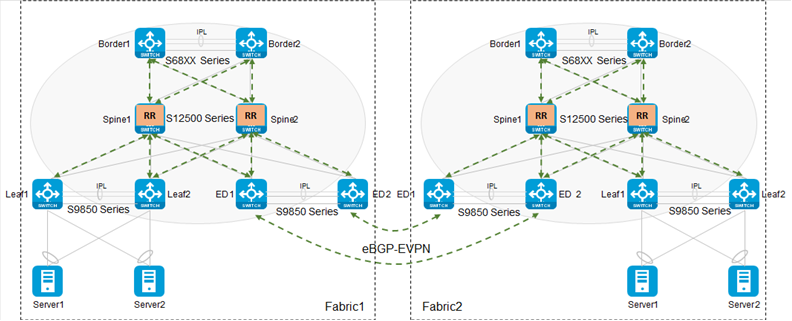
PID | Description |
LS-9850-4C | H3C S9850-4C L3 Ethernet Switch with 4*Interface Module Slots |
LS-9850-4C-H1 | H3C S9850-4C-H1 L3 Ethernet Switch with 4*Interface Module Slots |
LS-9850-32H-H1 | H3C S9850-32H L3 Ethernet Switch with 32 QSFP28 Ports |
LS-9850-32H-H1 | H3C S9850-32H L3 Ethernet Switch with 32 QSFP28 Ports |
LS-9850-32H-G | H3C S9850-32H-G L3 Ethernet Switch with 16*QSFP28 Ports and 16*QSFP28 Ports or 4*QSFP-DD Ports, Without Power Supplies |
Power |
|
LSVM1AC650 | 650W AC Power Supply Module(Air Inlets in Panel) |
LSVM1DC650 | 650W DC Power Supply Module(Air Inlets in Panel) |
PSR450-12A1 | 450W AC Power Supply Module (Power Panel Side Exhaust Airflow) , for LS-9850-32H-G |
PSR450-12A | 450W AC Power Supply Module (Power Panel Side Intake Airflow) , for LS-9850-32H-G |
PSR450-12D | 450W DC Power Supply Module (Power Panel Side Exhaust Airflow) , for LS-9850-32H-G |
Fan |
|
LSWM1FANSAB | Fan Module (SW, 4056, DC, Air Outlets in Panel), for S9850-32H |
LSWM1FANSA | Fan Module (SW, 4056, DC, Air Inlets in Panel) , for S9850-32H |
LSWM1BFANSCB | Fan Module with Port to Power Airflow, for S9850-4C |
LSWM1BFANSC | Fan Module with Power to Port Airflow, for S9850-4C |
LSPM1FANSA-SN | H3C Fan Module (Fan Panel Side Intake Airflow), for LS-9850-32H-G |
LSPM1FANSB-SN | H3C Fan Module (Fan Panel Side Exhaust Airflow) , for LS-9850-32H-G |
Module | |
LSWM18QC | 8-Port QSFP Plus Interface Card |
LSWM124XG2Q | 24-Port SFP Plus and 2-Port QSFP Plus Interface Card with MACSec |
LSWM124XGT2Q | 24-Port 10GBASE-T and 2-Port QSFP Plus Interface Card with MACSec |
LSWM124XG2QL | 24-Port SFP Plus and 2-Port QSFP Plus Interface Card |
LSWM124XG2QFC | 24 Ports SFP Plus and 2 Ports QSFP Plus Interface Card with FC |
LSWM18CQ | H3C 8-Port 100G Ethernet Optical Interface Module(QSFP28) |
LSWM116Q | H3C 16-Port 40G Ethernet Optical Interface Module(QSFP Plus) |
LSWM124TG2H | H3C 24-Port 25G Ethernet Optical Interface (SFP28) and 2-Port 100G Ethernet Optical Interface (QSFP28) Module |
LSWM18CQMSEC | H3C 8-Port 100G MACSEC Ethernet Optical Interface Module(QSFP28) |
Transceiver |
|
SFP-GE-LH80-SM1550 | 1000BASE-LH80 SFP Transceiver, Single Mode (1550nm, 80km, LC) |
SFP-FE-LX-SM1310-A | 100BASE-LX SFP Transceiver, Single Mode (1310nm, 15km, LC) |
SFP-FE-SX-MM1310-A | 100BASE-FX SFP Transceiver, Multi-Mode (1310nm, 2km, LC) |
SFP-FE-LH40-SM1310 | 100BASE-LH40 SFP Transceiver, Single Mode (1310nm, 40km, LC) |
SFP-GE-LX-SM1310-A | 1000BASE-LX SFP Transceiver, Single Mode (1310nm, 10km, LC) |
SFP-GE-LH40-SM1310 | 1000BASE-LH40 SFP Transceiver, Single Mode (1310nm, 40km, LC) |
SFP-GE-LH40-SM1550 | 1000BASE-LH40 SFP Transceiver, Single Mode (1550nm, 40km, LC) |
SFP-GE-SX-MM850-A | 1000BASE-SX SFP Transceiver, Multi-Mode (850nm, 550m, LC) |
SFP-GE-T | SFP GE Copper Interface Transceiver Module (100m,RJ45) |
Cable |
|
QSFP-100G-4SFP-25G-CAB-5M | 100G QSFP28 to 4x25G SFP28 5m Passive Cable |
QSFP-100G-4SFP-25G-CAB-3M | 100G QSFP28 to 4x25G SFP28 3m Passive Cable |
QSFP-100G-4SFP-25G-CAB-1M | 100G QSFP28 to 4x25G SFP28 1m Passive Cable |
QSFP-100G-D-CAB-5M | 100G QSFP28 to 100G QSFP28 5m Passive Cable |
QSFP-100G-D-AOC-20M | 100G QSFP28 to 100G QSFP28 20m Active Optical Cable |
QSFP-100G-D-AOC-10M | 100G QSFP28 to 100G QSFP28 10m Active Optical Cable |
QSFP-100G-D-AOC-7M | 100G QSFP28 to 100G QSFP28 7m Active Optical Cable |
QSFP-100G-D-CAB-3M | 100G QSFP28 to 100G QSFP28 3m Passive Cable |
QSFP-100G-D-CAB-1M | 100G QSFP28 to 100G QSFP28 1m Passive Cable |
QSFP-40G-D-AOC-20M | 40G QSFP+ to 40G QSFP+ 20m Active Optical Cable |
QSFP-40G-D-AOC-10M | 40G QSFP+ to 40G QSFP+ 10m Active Optical Cable |
QSFP-40G-D-AOC-7M | 40G QSFP+ to 40G QSFP+ 7m Active Optical Cable |
LSWM1QSTK5 | 40G QSFP+ to 4x10G SFP+ Cable 5m |
LSWM1QSTK4 | 40G QSFP+ to 4x10G SFP+ Cable 3m |
LSWM1QSTK3 | 40G QSFP+ to 4x10G SFP+ Cable 1m |
LSWM1QSTK2 | 40G QSFP+ Cable 5m |
LSWM1QSTK1 | 40G QSFP+ Cable 3m |
LSWM1QSTK0 | 40G QSFP+ Cable 1m |
Resource Center
- Cloud & AI
- InterConnect
- Intelligent Computing
- Intelligent Storage
- Security
- SMB Products
- Intelligent Terminal Products
- Product Support Services
- Technical Service Solutions
Product Support Services
Technical Service Solutions
- Resource Center
- Policy
- Online Help
- Technical Blogs
Resource Center
Policy
Online Help
- Become A Partner
- Partner Policy & Program
- Global Learning
- Partner Sales Resources
- Partner Business Management
- Service Business
Global Learning
- Profile
- News & Events
- Online Exhibition Center
- Contact Us

 Products and Solutions
Products and Solutions